
Ever wondered if a password manager could do more than just store your passwords? Dashlane doesn’t just keep your login info safe — it also throws in a built-in VPN and real-time dark web monitoring. But how well do these extra features really work, and are they worth the slightly higher price tag? Keep reading to see what we found in our hands-on testing.
For years, Dashlane has been a standout in the password manager world. It combines strong security, a user-friendly design, and plans for individuals, families, and businesses. Even with all these features, Dashlane manages to stay surprisingly simple to use, which isn’t always the case with feature-packed password managers.
Curious to see Dashlane in action? Jump ahead to our in-depth hands-on testing section
to find out how it performs in real-world scenarios — from login autofill and password sharing to its VPN and security alerts. You might be surprised by what we uncovered.
| Website | Dashlane.com |
| Platforms | Windows, macOS, Android, iOS |
| Browser extensions | Chrome, Safari, Firefox, Opera, Edge |
| Free version | 14-day trial |
| Encryption | 256-bit AES |
| Support | Email, chatbot, live chat, how-tos |
| Price | From $2.50/month |
Let’s start with a quick summary of the main pros and cons:
+ Pros
- Account recovery (with business plan only)
- Automatic password updates with many popular sites
- Complies with GDPR and CCPA
- Dark web monitoring
- Data encrypted in transit and at rest
- Encrypted file storage
- Hotspot Shield VPN included with personal plans
- Individual, family, and business plans
- Passwords encrypted locally
- Passwords stored in the cloud and on your device
- Secure password sharing
- Supports all major platforms and apps
– Cons
- Based in (and data stored in) the USA
- May collect and share some user data
- May disclose user data
- No multi-factor authentication
- No published audit results
- Limited support
Now, let's dive into the details of this Dashlane review.
Dashlane feature summary

Here’s a quick summary of what Dashlane offers (with some features limited to paid plans):
- Security & encryption: AES-256 and Argon2 protection, applied on your device and during transit.
- Password management: import/export, secure generation, sharing, one-click changing, and strength checks.
- Convenience tools: autofill for forms and payments, secure notes, and receipt capture.
- Monitoring & alerts: inbox scanning, live dark web monitoring, and real-time security notifications.
- Premium extras: built-in VPN, 1GB of encrypted file storage, and unlimited device sync.
- Business features: advanced analytics, reporting, and 24/7 support for teams.
- Cross-platform compatibility: works smoothly on Windows, macOS, Linux, iOS, Android, and all major browsers.
Company information and background
Dashlane is a venture-funded company that has reportedly raised over $200 million in venture funding over the years and passed 10 million users in 2018. This gives them the size and resources to support even the largest customers, a characteristic that many of their competitors lack.
The company is based in New York City, USA. This is unfortunate, since it puts them in Five Eyes territory. The Five Eyes Alliance (FVEY) is a major intelligence gathering and sharing alliance, with the United States at its heart. Many privacy advocates advise against using services that are based in any of the FVEY countries.
Terms of Service
I reviewed the Dashlane Terms of Service (TOS) that were updated March 15, 2024 (the most current as of the date of this review). I appreciate the way Dashlane included a small, “plain English” explanation at the top of each section of the TOS, since the document itself is long and heavy on legalese.
Despite being long and detailed, the TOS was rather vague in a few areas that are important to people who prioritize privacy above everything else. Under “Usage Information”, it's stated that:
“Dashlane owns all data regarding installation, registration, and the use and performance of the Services, including usage statistics and activity logs, (collectively, “Usage Information”). See the Privacy Policy for additional information.”
It isn’t clear what data is included in Dashlane usage statistics and activity logs. Nor whether this applies to the VPN as well as the password management elements of the product. What I do know is that the best privacy-oriented VPN services, such as ExpressVPN and NordVPN, categorically state that they do not keep any usage statistics or activity logs.
Finally, under Cooperation, Dashlane states that:
“Nothing in these Terms limits our obligation to cooperate with valid orders from regulatory authorities.”
Dashlane Privacy Policy
The Dashlane Privacy Policy is likewise long and difficult. It needs to comply with US laws, as well as the European Union (GDPR) and the California Consumer Privacy Act, so that’s no surprise.
The company says it tries to collect the minimum amount of user personal information (personally identifiable information or PII) it can. This includes your email address and your phone number (if you choose to provide it). However, it’s clear that it doesn’t know your master password and can’t decrypt the data you store in Dashlane.
However, there are cases where it will record more PII than this. If you sign up for a paid plan, Dashlane stores the expiration date of your credit card as well as the last four digits of that card. It also states that:
“We may be able to access the name, address, and phone number associated with a payment method on a payment processor’s service, but this information is only stored by the processor.”
I’m not sure why a payment provider would pass this data to Dashlane. I’m also not thrilled that Dashlane doesn’t say anything about what it does with such data if it is accessible.
Add in the data about your connection that the company automatically gathers, operating system name and version, device identifier, browser type, browser language, and IP address, and it will be able to create a pretty detailed profile for you.
Because the company is based in the United States, it is subjected to US law and easily accessible to US intelligence agencies. Legally, Dashlane can be compelled to give up whatever information it has on you, and as it pointed out in the TOS, it has the right to give up any information about you voluntarily.
It can also disclose your personal data if it believes it is necessary to protect its rights or the services.
What about Dashlane security audits?
Dashlane has a patented security architecture and states that “our products are audited regularly and by different security auditors.” However, I could not find any published audit results. The closest I came was a 2016 paper by a group of students at MIT, who found no major vulnerabilities.
Dashlane apps
Dashlane runs smoothly across all major operating systems and browsers. It has dedicated apps for Windows and macOS, while Linux machines and Chromebooks rely on the browser extension instead of native clients. On mobile, Dashlane supports iOS (15 and above) and Android (8 and above).

For browsers, Dashlane officially supports Chrome, Firefox, Safari, and Edge, though it also works reliably with Brave and Opera. On top of that, there’s a full-featured web app that you can access from any major browser. If you’re on a paid plan, your data will automatically stay synced across all devices and platforms.
Dashlane hands-on testing
For this Dashlane review, I took advantage of the 14-day free trial and installed it on a computer running Microsoft Windows and Google Chrome.
This is a great way to test the waters before deciding whether to upgrade. Since Dashlane’s paid plans are on the pricier side, using the free trial gives you a clear sense of the interface, features, and overall workflow — without any upfront commitment.
Installing Dashlane
The Dashlane installer installed the Dashlane Desktop app without any issues.
Then, it guided me through creating an account and installing the Dashlane Browser Extension for Google Chrome. The process works well, and Dashlane guides you through everything to make the process as easy as possible.
To create an account with Dashlane, you’ll be asked to enter a username, password, and a valid email address. After this, Dashlane will send a confirmation message to that address, and once you reply to that, you will be ready to go.
If you want to increase the security of your passwords, you can enable basic two-factor authentication (2FA) on your account. The business versions of Dashlane gives you additional 2FA options. You can also see the details on how Dashlane implements 2FA.
Importing passwords and other data to Dashlane
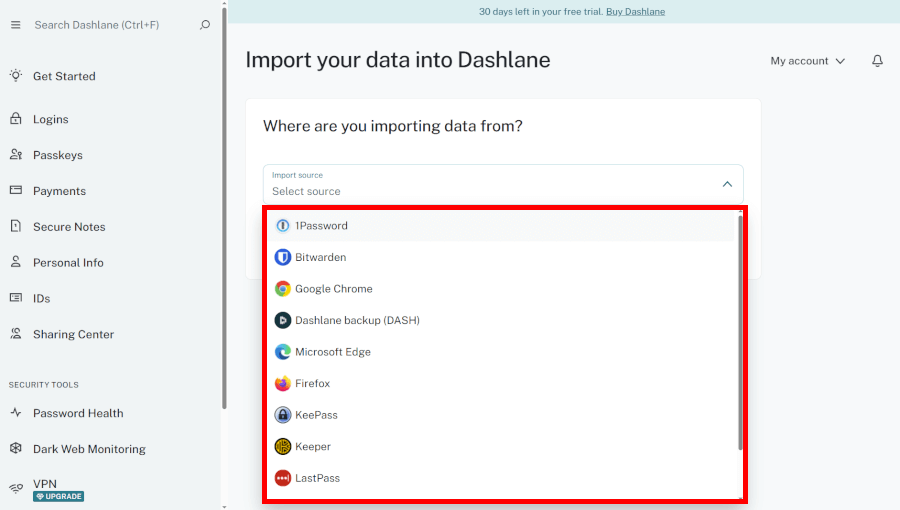
Once you have your account, you need to get your passwords and other data into Dashlane. You could do it manually, but you don’t have to. Dashlane enables you to import your passwords from many sources.
Dashlane can import passwords and other data from:
- Chrome
- Firefox
- Internet Explorer
- LastPass
- 1Password
- Roboform
- PasswordWallet
- KeePass
To import from one of these, open the File menu in the Dashlane Desktop app and select Import Passwords. The app will walk you through the process.
If your passwords are stored somewhere else, don’t panic. Dashlane can also import passwords using a Custom CSV file. If this applies to you, this page will tell you how to make it happen.
Entering passwords and data manually into Dashlane
If you do want or need to enter some passwords manually, you’ll be doing it through the Desktop app as well.
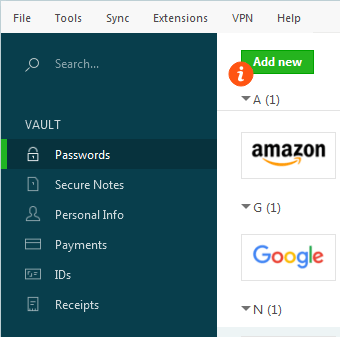
In the menu on the left side of the app, click Passwords in the Vault section. Then just hit the Add new button to add the password data by hand. If this is the first time you’ve gone through the process in the app, you can click the orange circle with the letter “i” in it (as seen in the previous image) to be guided through the process.
Letting Dashlane capture a password itself
The final way to add credentials is to log into a page with the browser. Once you enter the username and password, and log into the site, Dashlane will recognize what you are doing, and offer to add that information to the vault, like this:
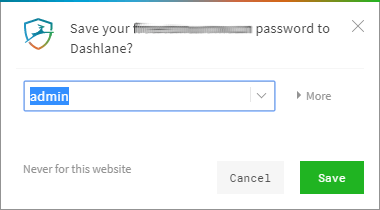
While Dashlane is good at this, no password manager can capture information from 100% of the sites out there. So don’t get upset if Dashlane sometimes fails to get it right and you need to enter the data for a particular site manually.
Working with your passwords
Once you add a couple of passwords to Dashlane, you can open the browser extension and see what’s in your vault. It will look something like this:
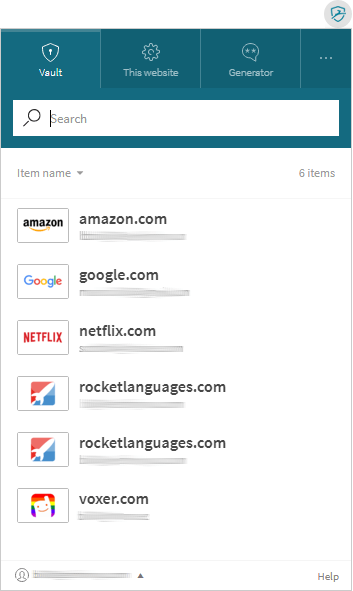
This is one place where Dashlane can feel kind of clumsy. You need to work with different components of Dashlane depending on what you want to do. Here’s what I mean:
Use the extension if you just need quick access to passwords, but switch to the web app for the complete toolkit: Passwords, Secure Notes, Personal Info, and Payments.
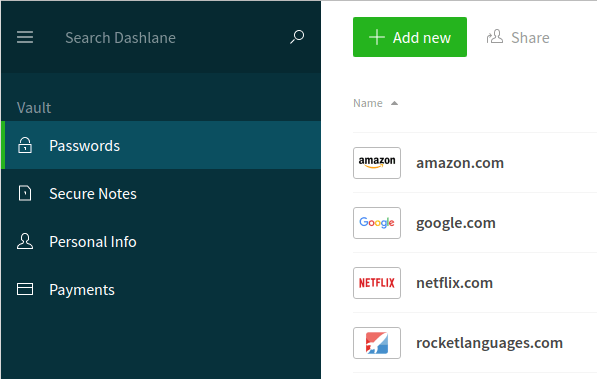
The desktop client gives you all of those, plus IDs and Receipts as we saw earlier.
Dashlane password generator
One of the best things about password managers is that they allow you to use strong passwords without having to memorize a complex sequence like the password in the following image:
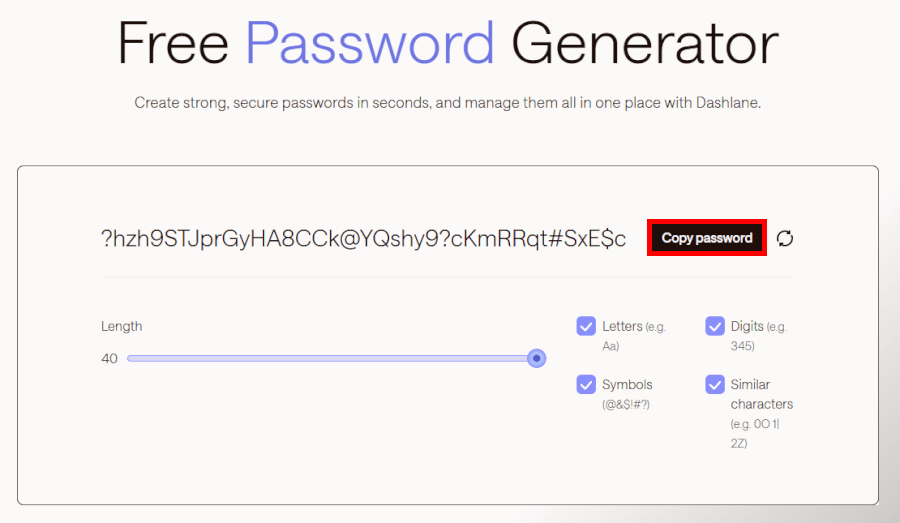
Dashlane includes a configurable password generator. As you can see above, you can control the use of letters, digits, symbols, length, and the use of ambiguous characters.
The Dashlane password generator isn’t as configurable as the one in some of the competition, but it certainly does the job. I would, however, suggest increasing the length of the passwords it generates. I recommend creating passwords with a minimum length of 16, for added difficulty in cracking them.
Editing your data
Dashlane works a lot like Bitwarden in that it stores an encrypted copy of your data on each device while also keeping a copy in the cloud on Dashlane’s servers. This setup makes syncing easy — every device communicates with the server copy, so whenever you log in from a new device, your passwords and personal data sync automatically.
But what happens if a device goes offline for a while? You might make changes on that device or on another, and when the offline device reconnects, Dashlane suddenly has two different versions of the same item.
Some password managers avoid this mess by blocking changes on a device when it can’t reach the server. Dashlane takes a different approach. In my test, I was able to edit data offline, and once I reconnected, Dashlane didn’t reject the change or overwrite it across devices. Instead, it simply created a new duplicate entry in the Vault and left it up to me to sort things out.
Depending on your perspective, this could be a good thing — at least you aren’t locked out of making changes offline. But it also means you may end up with duplicate entries to clean up later. If that happens, Dashlane has a help page with steps on how to fix the problem.
Dashlane in action
Once you are done with all the preliminaries you are ready to put Dashlane to work. Whenever you visit a web page that Dashlane has data for, it will display the Dashlane icon in any of the date fields it “knows.” Click the icon to fill all the relevant fields.
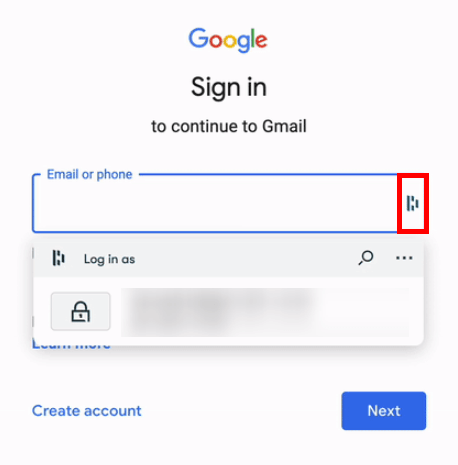
If you have more than one password for this page (multiple email accounts with the same provider for example) Dashlane will display a list of the information it has for that page. Select one of the options and Dashlane will fill the appropriate fields on the page.
Additional Dashlane features
We’ve touched on the basics, but Dashlane has far more to offer. Some of these additional features are common to other password managers, and some are unique. To help you out, I’ve included short descriptions of the coolest or most unique features.
Sharing passwords
Dashlane lets you store and share as many passwords as you need, with no limits on how many items you can send to others. This makes it easy to collaborate or securely give someone access without worrying about caps.
1 GB secure file storage
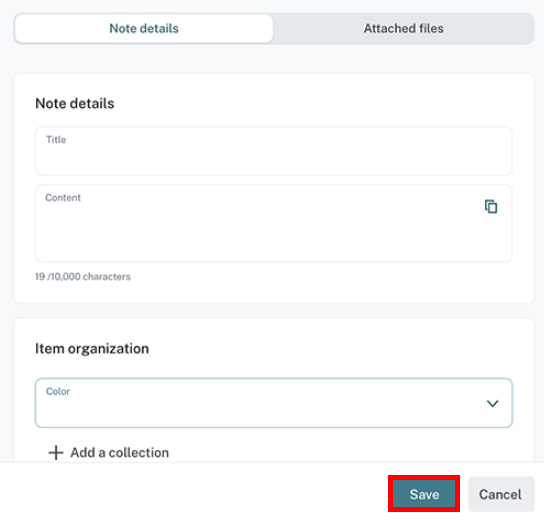
Paid versions of Dashlane give you 1GB of encrypted file storage, with individual files limited to 50MB in size. To use this storage space, you create a Secure Note in Dashlane. You can attach one or more files to a Secure Note, which gives you a way to logically organize the documents. The documents you attach to a Secure Note are encrypted and synced throughout Dashlane just like your passwords and other data.
Password health analysis and fixes

Think of Dashlane’s Password Health as a personal password doctor. It scans your vault for weak, reused, or compromised passwords and gives each one a health score. Spot a problem? No sweat—Dashlane’s Password Generator whips up a stronger password, and the Password Changer can update it for you automatically on supported sites. It’s like giving your entire vault a security tune-up without lifting a finger.
Sharing data in an emergency
If something were to happen to you, Dashlane lets you prepare for emergencies by securely sharing all your vault data with a trusted person. The initial “Emergency Contact” feature is discontinued, but this manual export/import method offers full control.
How it works
- Export a DASH file
- From Dashlane’s web app (Chrome/Firefox) or Android app, export your entire vault to a DASH file—an encrypted backup protected by a unique password you choose.
- Store and share the file
- Save the DASH file somewhere secure (e.g., USB drive, safe) or share it via email/cloud—but never share the file and its password together. Dashlane recommends physically storing the file and sending the password in a separate step.
- Send the password separately
- Best practice: create a Dashlane Secure Note, share it with your trusted contact ahead of time, and include the password (plus instructions/location information) in the note.
- Import in an emergency
- Your trusted person needs two things: the DASH file and its password. They can import it into any Dashlane account (even a new one) via the web app or Android app (no iOS/macOS support).
- They’ll gain full access to all your stored logins, secure notes, and 2FA tokens.
Dark web monitoring
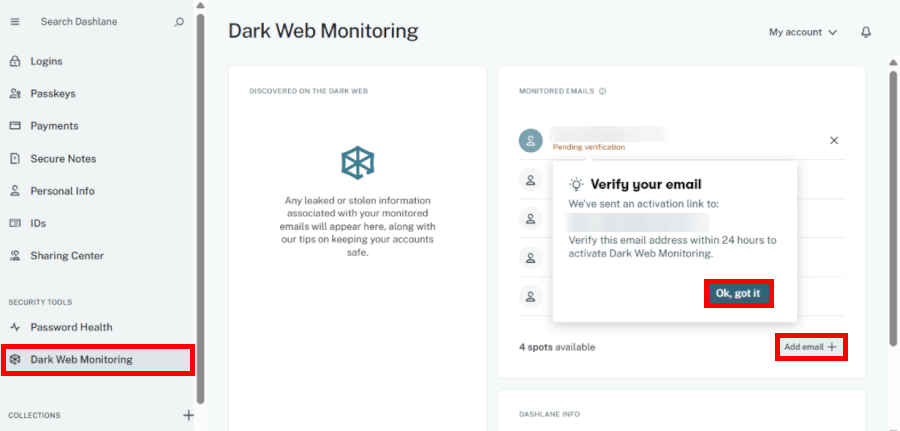
Online databases are constantly getting hacked and breached, potentially exposing our personal data to all sorts of bad guys. Dark web monitoring is Dashlane’s answer to the problem. It scans the Internet (specifically the portion known as the Dark Web) looking to see if any of your email addresses appear there. If so, it will you an alert so you can deal with the problem before some creep takes advantage of it.
VPN service
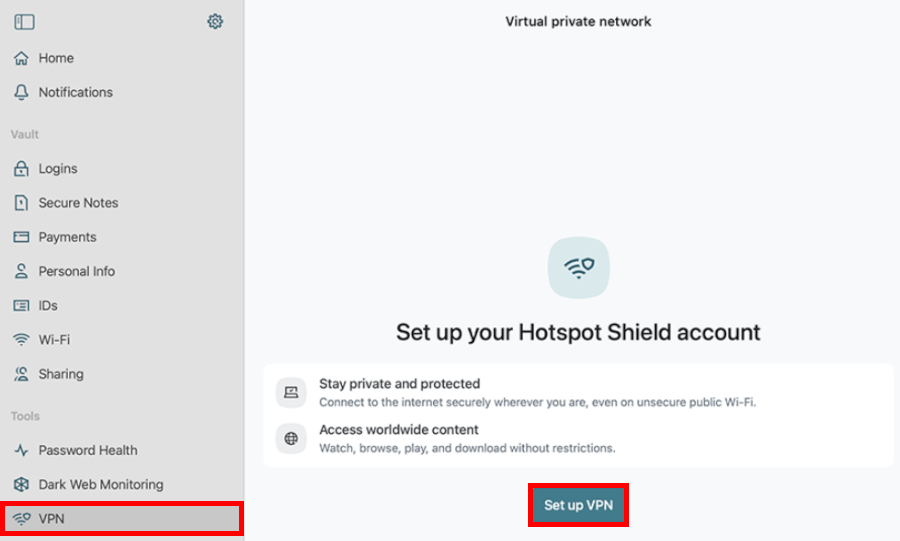
A VPN helps protect your privacy when using the internet (see What is VPN). Dashlane provides paid Premium plan users with access to the Hotspot Shield VPN service. It's recommended that you connect to the VPN whenever you feel the need for additional privacy protection. Using a VPN is particularly important when using public WiFi hotspots, as these are often targeted by hackers and other unsavory characters.
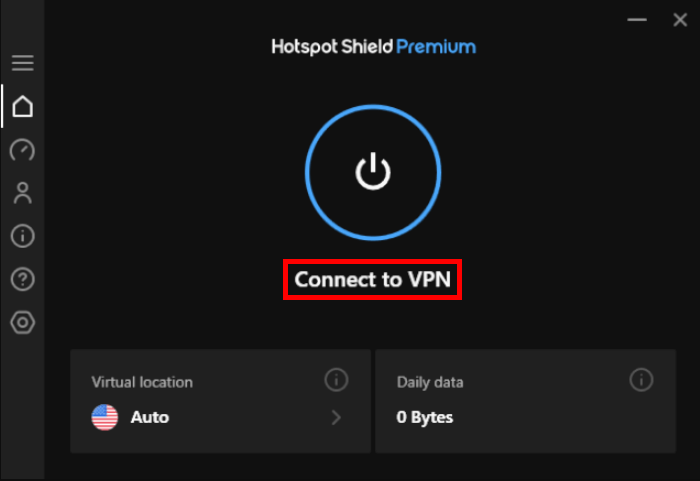
Unfortunately, Hotspot Shield is certainly not the best VPN service and has been involved in lots of controversies:
- It was directly identified in an academic paper for “actively injecting JavaScript codes using iframes for advertising and tracking purposes” with their Android VPN app.
- Hotspot Shield also made headlines for leaving its users vulnerable to having their location exposed, as explained here.
Overall, VPNs are a very important privacy tool to keep your data safe, but I would consider other options, rather than using Hotspot Shield through Dashlane.
Unfortunately, the same fate befell identity restoration and identity theft insurance features, since they were part of the “Premium Plus plan” which is off the menu.
While credit monitoring, identity restoration, and identity theft insurance are only marginally related to password management, they made Dashlane stand out in the sea of similar password managers — it’s a shame they are no longer part of its plans.
However, if you wish to know how can you shield yourself against identity theft and identity fraud without a credit monitoring service, check out our guide.
Support: Getting help with Dashlane
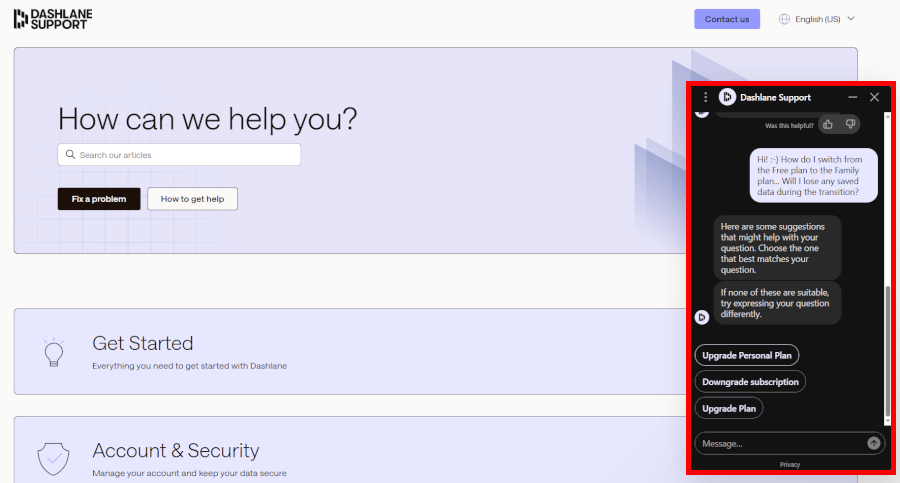
Dashlane offers live chat support Monday–Friday (9 AM to 6 PM EST), plus a handy support chatbot that handles quick questions anytime. You’ll also find email support and a helpful Support Page, though there’s no phone support available.
I have not had any problems with Dashlane Support. However, consumer review sites like the Better Business Bureau (BBB) and Trustpilot gave the Support team very mixed reviews.
How secure and private is Dashlane?
When it comes to security, Dashlane is one of the strongest players in the game. Your data is protected using AES-256 and Argon2 encryption, the same standard used by the US government for top-secret information. On top of that, Dashlane has even earned a US patent for its unique security architecture.
Here are some of the key protections you get:
- Patented, zero-knowledge security architecture that ensures Dashlane cannot see or reset your master password.
- Industry-leading master password requirements, with no way for anyone but you to reset it.
- Built-in two-factor authentication for every new device login.
- A security dashboard that highlights weak or compromised passwords and instant alerts if your accounts are caught in a data breach.
That said, Dashlane isn’t without its drawbacks. The company collects some personal data (such as email and billing info) and, because it’s based in the United States, it can be compelled to hand over information to government authorities. Also, only parts of its codebase are open source, meaning users still need to trust the company on how the rest is implemented.
Even with these caveats, your data in Dashlane stays encrypted on your device and out of reach to anyone else. The only catch is its US-based privacy limitations.
Plans and pricing: How much Dashlane costs
On September 16, 2025, Dashlane retired its “Free” plan. The company now focuses fully on its paid plans. Individuals can choose Premium, families have Friends & Family, and professionals get Password Management or Omnix. These plans offer real features — password syncing across devices, dark web monitoring, secure notes, and more.
Dashlane personal plans (Premium and Friends & Family)
| Dashlane personal plans | Pricing |
| Premium | $2.50/month (billed annually) |
| Friends & Family (for 10 members) | $3.75/month (billed annually) |
The Premium plan gives you unlimited passwords, syncing across all your devices, plus extras such as dark web monitoring, VPN access, unlimited password sharing, and advanced authentication.
Need coverage for more people? The Friends & Family plan supports up to 10 accounts, giving everyone the same premium features.
Dashlane business plans (Password Management and Omnix)
| Dashlane business plans | Pricing (billed annually) |
| Password Management | $6/per user/month |
| Omnix | $11/per user/month |
Dashlane’s Password Management plan secures employee access with unlimited passwords, passkeys, and group sharing, while giving admins easy control through a smart console and integrations like SSO, SCIM, and SIEM.
For more advanced protection, Omnix adds AI-powered credential security. It identifies risks, alerts employees in context, and includes phishing protection — turning password management into a proactive defense system for your organization.
Dashlane alternatives: Other password managers to consider
If Dashlane isn’t quite the right fit, there are several solid alternatives worth considering, each with unique strengths in security and usability:
Built by the Proton team behind Proton Mail and VPN, Proton Pass is a privacy-first, open-source manager with end-to-end encryption and dark web monitoring. Its generous free plan covers unlimited logins and device sync for one user, plus 10 email aliases, making it ideal for privacy-conscious users. Compared to Dashlane, Proton Pass leans more on privacy and community trust than flashy enterprise tools.
1Password combines serious security with clean usability. Features like Travel Mode, Watchtower alerts, and a unique “Secret Key” encryption layer make it perfect for individuals and businesses who want extra safeguards. While it lacks a free tier, it’s a solid pick if you value polished design and thoughtful security over cost, Dashlane offers more built-in convenience, but 1Password feels more customizable.
Bitwarden is a self-host-friendly, open-source option with AES-256 encryption, multi-device sync, and a surprisingly strong free plan. It’s wallet-friendly and transparent, but being US-based might raise privacy concerns. Compared to Dashlane, it’s less flashy but gives tech-savvy users total control and flexibility at a fraction of the price.
Dashlane FAQ
Dashlane’s zero-knowledge encryption means your data is locked tight — only you hold the master key, and not even Dashlane can access your passwords. Your information is encrypted on your device before it ever leaves, keeping prying eyes completely out of the picture.
Yes, with a Premium or Friends & Family plan, your passwords and data sync seamlessly across all your devices, so you’re always protected whether you’re on a phone, tablet, or laptop.
Since Dashlane can’t reset your master password, the first step is to try account recovery if you set it up. Otherwise, you’ll need your recovery key or another approved device to regain access, keeping your security airtight.
Dashlane Omnix is the next-level business solution — it includes everything in the standard Password Management plan plus AI-driven credential protection, real-time alerts, and phishing defense, giving companies proactive protection against breaches.
Conclusion: How Dashlane stacks up
So, is Dashlane still one of the top password managers out there? The short answer: Yes. It combines all the essentials you’d expect from a password manager with some standout extras, all wrapped up in a sleek, easy-to-use interface.
Here’s what makes Dashlane shine:
- Unlimited passwords and cross-device sync – Keep all your logins up to date everywhere.
- Zero-knowledge encryption and 2FA – Your data stays locked tight, only you can access it.
- Dark web monitoring – Get alerts if your info appears in breaches.
- Built-in VPN – An extra layer of online security for your devices.
- User-friendly design – Simple enough for beginners, powerful enough for pros.
Of course, no tool is perfect. Dashlane is based in the US, which may be a privacy concern if you’re especially cautious about government surveillance. And while its premium plans come with a price tag, the features and security you get make it a solid investment in your online safety.
If you’re curious, take advantage of Dashlane’s 30-day personal trial or 14-day trial. It’s a risk-free way to see if Dashlane fits your digital lifestyle before committing.
Lastly, here are some other password manager reviews you may want to check out as well:

Further to my info re. Dashlane — You might have a look at the Emergency Contact/Access feature in NordPass:
https://nordpass.com/blog/introducing-emergency-access/
Please note that for a couple of years already, Dashlane does NOT has the Emergency Contact Access as before.
The 2025 Emergency Contact Access feature ONLY consists of handing out your Master Password OR the location of your Dashlane data and the password for that file to a trusted person.
I have been a Dashlane user as early as 2014, when the Emergency Contact Access was available, but unfortunately not anymore — therefore please adapt your review of Dashlane 2025.
Hi Robby,
Thanks for bringing this to our attention. The review has been updated to reflect this change.